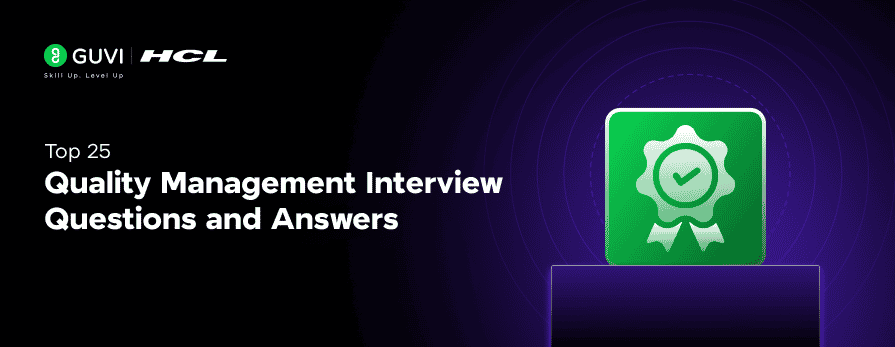
Top 25 Quality Management Interview Questions and Answers for All Levels
Jul 21, 2025 7 Min Read 2997 Views
(Last Updated)
How you prepare for quality management interview questions can make or break your chances of landing a role in this growing field. Quality management is a well-defined system that ensures that businesses maintain excellence, which is why interviewers assess your knowledge of quality control tools, ISO standards, and problem-solving approaches.
When preparing for quality manager interviews, you need to understand both product and process quality concepts. Your preparation must be comprehensive, from basic quality management interview questions and answers for entry-level positions to advanced scenarios for experienced professionals.
This guide covers everything you need to know—from fundamental concepts to scenario-based challenges. We’ve organized the questions by difficulty level so you can focus on what’s relevant for your career stage. Additionally, I’ve provided concise, practical answers to help you demonstrate your expertise confidently during your next interview. Let’s begin!
Table of contents
- Basic Quality Management Interview Questions and Answers
- What is quality management?
- What are the responsibilities of a Quality Manager?
- What is the difference between quality assurance and quality control?
- What is a Quality Management System (QMS)?
- What are the key principles of ISO 9001?
- Intermediate-Level Quality Management Interview Questions and Answers
- How do you handle customer complaints?
- What is the PDCA cycle?
- How do you ensure compliance with quality standards?
- What are some common quality tools you've used?
- How do you prioritize tasks in a quality role?
- Advanced-Level Quality Management Interview Questions and Answers
- How do you align quality goals with business objectives?
- How do you implement ISO 9001 in a dynamic organization?
- How do you measure the ROI of quality initiatives?
- How do you manage quality across multiple teams or locations?
- How do you balance cost and quality in a project?
- Scenario-Based Quality Management Interview Questions and Answers
- A supplier delivers defective materials. What do you do?
- Your team misses KPIs repeatedly. How do you respond?
- A customer complains about recurring defects. What's your approach?
- You find a major non-conformance during an audit. What's next?
- Management wants faster delivery at the cost of quality. How do you handle it?
- Technical and Conceptual Quality Management Interview Questions and Answers
- What is the difference between product and process quality?
- What is Six Sigma, and how is it applied?
- What is a Fishbone Diagram used for?
- What is the role of documentation in quality management?
- What is the difference between ISO and CMM?
- Concluding Thoughts…
Basic Quality Management Interview Questions and Answers
Preparing for basic quality management interview questions and answers requires understanding the fundamental concepts. These entry-level questions form the foundation of your quality management knowledge and are essential regardless of your experience level.
1. What is quality management?
Quality management ensures that an organization, product, or service consistently performs as intended. It comprises four main components:
- Quality planning: Establishing quality objectives and requirements
- Quality assurance: Focusing on preventing defects through process design
- Quality control: Identifying defects in finished products
- Quality improvement: Continuously enhancing processes and outcomes
Quality management focuses on meeting customer requirements and enhancing satisfaction by maintaining consistent standards throughout the organization.
2. What are the responsibilities of a Quality Manager?
Quality Managers ensure products or services are fit for purpose, legally compliant, and meet customer expectations. Their core responsibilities include:
- Devising and establishing quality procedures, standards, and specifications
- Reviewing customer requirements and ensuring they are met
- Setting up and maintaining documentation procedures
- Monitoring performance through relevant data collection
- Identifying improvement areas and implementing changes
- Leading continuous improvement initiatives
- Ensuring compliance with standards like ISO 9001:2015
- Training and managing quality control teams
Furthermore, Quality Managers liaise between the organization and regulatory agencies, customers, and external quality assurance organizations.
3. What is the difference between quality assurance and quality control?
Though often used interchangeably, these concepts serve different purposes:
Quality Assurance (QA):
- Process-oriented and proactive
- Focuses on preventing defects before they occur
- Involves the entire organization
- Includes documentation, audits, supplier management, and training
Quality Control (QC):
- Product-oriented and reactive
- Focuses on identifying defects after they happen
- Typically performed by a dedicated QC team
- Includes batch inspection, product sampling, and testing
Simply put, “Quality assurance is process-oriented and focuses on defect prevention, while quality control is product-oriented and focuses on defect identification”.
4. What is a Quality Management System (QMS)?
A QMS is a structured framework that defines and documents an organization’s processes, procedures, and responsibilities for achieving quality objectives. It helps:
- Coordinate activities to meet customer and regulatory requirements
- Reduce waste and increase efficiency
- Prevent mistakes and lower costs
- Define, improve, and control processes
Common QMS approaches include standardized systems like ISO 9001, Total Quality Management (TQM), Lean management, and Six Sigma.
5. What are the key principles of ISO 9001?
ISO 9001, the world’s most recognized quality management standard, is built on seven quality management principles:
- Customer focus – Meeting and exceeding customer expectations
- Leadership – Creating unity of purpose and direction
- Engagement of people – Involving competent, empowered people at all levels
- Process approach – Managing interrelated processes as a system
- Improvement – Maintaining ongoing focus on improvement
- Evidence-based decision making – Using data analysis for better results
- Relationship management – Managing relationships with interested parties
These principles guide organizations in improving performance, enhancing customer satisfaction, and achieving sustained success.
Intermediate-Level Quality Management Interview Questions and Answers
Moving beyond the fundamentals, intermediate-level quality management interview questions and answers assess your practical knowledge and problem-solving abilities. These questions delve into how you’d apply quality principles in real-world situations.
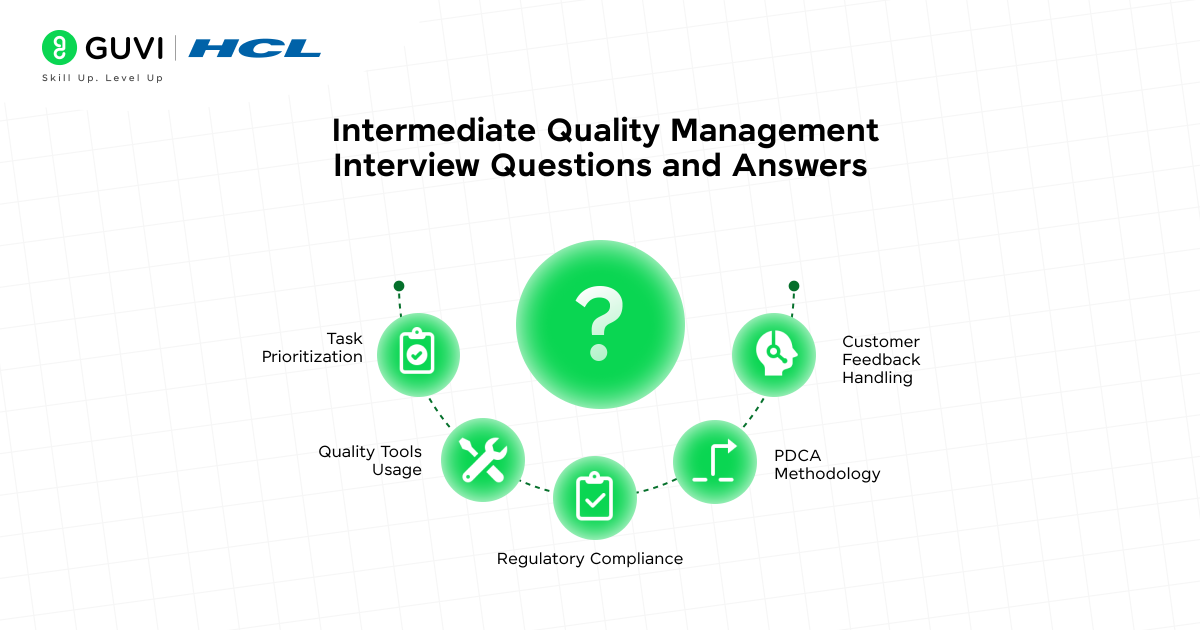
6. How do you handle customer complaints?
When handling customer complaints, follow this structured approach:
- Receive and acknowledge the complaint promptly, listening attentively and showing respect
- Document all relevant details, including date, customer name, product/service involved, and nature of the complaint
- Analyze root causes to understand what led to the issue
- Implement corrective actions to resolve the problem and prevent recurrence
- Verify the effectiveness of the solution
- Follow up with the customer to ensure satisfaction
Remember that complaints, when handled properly, can become business opportunities that increase customer loyalty while promoting continuous improvement. Essentially, each complaint offers a unique chance to enhance your products and services.
7. What is the PDCA cycle?
The PDCA cycle (Plan-Do-Check-Act) is a four-step model for continuous improvement in business process management, also known as the Deming Cycle or Shewhart Cycle. It works as follows:
- Plan: Identify an opportunity and develop a plan for change
- Do: Implement the plan on a small scale and collect data
- Check: Review results, analyze data, and identify lessons learned
- Act: Take action based on what you learned; standardize successful changes, or begin a new cycle
The PDCA cycle is particularly valuable within quality management because it provides a systematic approach to problem-solving and process improvement. Many organizations use this model to define most of their work processes, from strategic planning to daily operations.
8. How do you ensure compliance with quality standards?
To ensure compliance with quality standards:
- Implement a robust QMS (Quality Management System) that aligns with relevant standards like ISO 9001
- Maintain strict document control for specifications, procedures, and records
- Conduct regular internal audits to verify adherence to standards
- Provide comprehensive training to staff on quality requirements
- Use automated systems where possible to streamline compliance efforts
- Perform root cause analysis when non-conformances are detected
- Implement corrective actions promptly to address any compliance issues
Notably, appointing a dedicated compliance officer can help navigate the evolving regulatory landscape and champion corporate integrity within the organization.
9. What are some common quality tools you’ve used?
The seven basic quality tools, also known as the “quality control tools,” are essential for any quality professional:
- Cause and effect diagram (fishbone/Ishikawa diagram): Analyzes process dispersion and illustrates causes leading to an effect
- Check sheet: A simple data recording tool using tally marks to indicate occurrences
- Control chart: Shows process changes over time with control limits
- Histogram: Displays frequency distribution graphically
- Pareto chart: Based on the 80/20 rule, showing the relative importance of differences
- Scatter diagram: Analyzes potential relationships between two variables
- Stratification/Flowchart: Helps break down data into categories or display process sequences
These tools, when used in combination, significantly multiply their value in quality improvement activities.
10. How do you prioritize tasks in a quality role?
Task prioritization in quality roles requires balancing multiple responsibilities. Consider these factors:
- Urgency: Address time-sensitive issues first, especially those affecting customer safety
- Importance: Focus on tasks with the greatest impact on product quality and business objectives
- Resource availability: Consider what can realistically be accomplished with available resources
- Regulatory requirements: Prioritize compliance-related tasks to avoid potential penalties
- Customer impact: Give higher priority to issues directly affecting customer satisfaction
With this in mind, quality professionals should regularly reassess priorities as new information becomes available. Studies show that task prioritization ability differs across individuals but improves with practice, making it a vital skill for quality managers to develop.
Advanced-Level Quality Management Interview Questions and Answers
Advanced quality management interview questions and answers examine strategic leadership capabilities and how you translate quality principles into organizational value. Here’s how to demonstrate your expertise at this level.
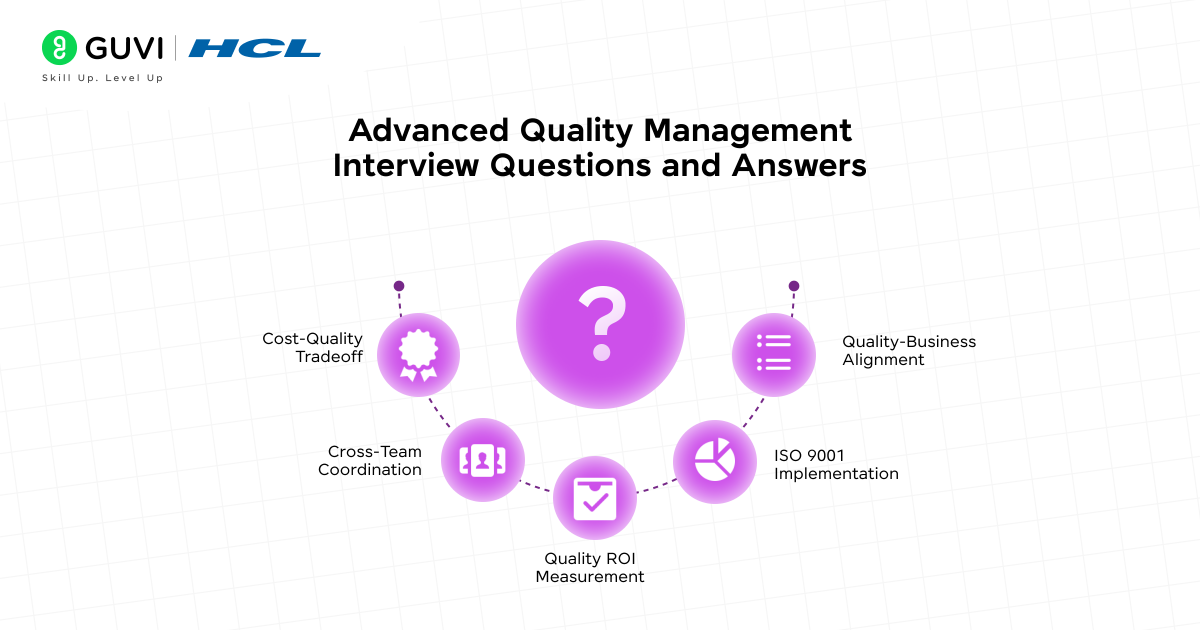
11. How do you align quality goals with business objectives?
Quality goals must directly support your organization’s broader strategy. First, understand the key business objectives through stakeholder engagement and strategic document review. Subsequently, translate these into measurable quality objectives that contribute to business outcomes.
For example, if a business aims to increase customer satisfaction, its quality goals might focus on reducing defects or improving response times. High-performing organizations are 3X more likely to use data analytics to monitor learning impact on business performance. Regular reporting helps demonstrate how quality initiatives contribute to financial outcomes and strategic priorities.
12. How do you implement ISO 9001 in a dynamic organization?
Implementing ISO 9001 in dynamic environments requires adaptability. Start with strong leadership commitment, as this sets the precedent for the entire organization. Develop a quality management system that’s flexible enough to accommodate change while maintaining compliance.
Accordingly, focus on:
- Simplifying processes rather than adding bureaucracy
- Ensuring knowledge transfer across departments
- Integrating quality objectives into daily operations
- Maintaining adaptable documentation practices
Remember that ISO 9001 should be tailored to your organization’s unique needs, not implemented as a rigid one-size-fits-all solution.
13. How do you measure the ROI of quality initiatives?
ROI calculation for quality initiatives follows this formula:
ROI = (Net financial returns from improvement actions / Financial investment in improvement actions) × 100%
To calculate effectively:
- Define scope and perspective (who incurs costs and receives benefits)
- Document implementation costs (investment)
- Measure revenue increases and cost reductions (returns)
- Divide net returns by implementation costs
For instance, an ROI of 1.8 indicates that for every rupee invested, Rs 1.80 is gained. This approach helps justify quality investments to leadership and prioritize future initiatives.
14. How do you manage quality across multiple teams or locations?
Managing quality across diverse locations requires standardization with flexibility. Establish clear quality standards while respecting cultural differences.
Key strategies include:
- Creating unified objectives that drive all teams forward
- Implementing robust communication channels for sharing best practices
- Leveraging technology and management software to track performance
- Standardizing brand guidelines while allowing for necessary adaptations
- Conducting regular quality audits across all locations
Maintain consistent product quality through automated inspection alerts and integrated quality control applications that provide real-time monitoring capabilities.
15. How do you balance cost and quality in a project?
The Project Management Triangle illustrates the interrelationship between quality, cost, and time. Adjusting one affects the others. To balance cost and quality:
- Identify cost-saving opportunities without compromising critical quality standards
- Define clear quality requirements at project initiation
- Implement quality control measures throughout the project lifecycle
- Leverage quality management systems like Six Sigma to reduce waste
- Conduct regular cost-benefit analyses of quality initiatives
Companies worldwide lose approximately Rs 200 crore every 10 seconds due to ineffective business strategy implementation, making this balance crucial for organizational success.
Scenario-Based Quality Management Interview Questions and Answers
Scenario-based quality management interview questions and answers evaluate your real-world decision-making abilities. These questions reveal how you apply quality principles under pressure—a critical skill for quality professionals at all levels.
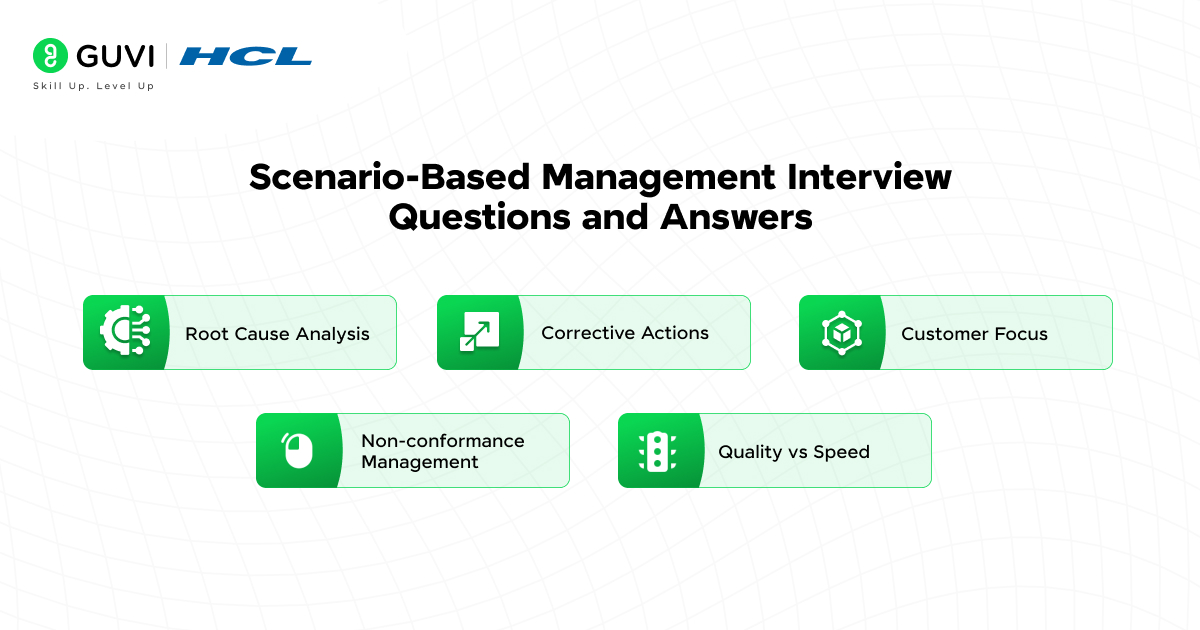
16. A supplier delivers defective materials. What do you do?
First, immediately segregate the defective materials to prevent their use in production. Next, document the issue thoroughly with photos and specifications. Contact the supplier promptly to report the problem and request corrective action. Conduct a thorough analysis to determine the impact on production and customer deliveries.
For long-term resolution:
- Request rework or replacement of affected materials
- Perform a re-inspection after correction
- Consider financial penalties or chargebacks as outlined in supplier agreements
- Update your quality control checklist to prevent recurrence
17. Your team misses KPIs repeatedly. How do you respond?
Initially, gather data to identify patterns in the missed KPIs. Conduct proper root cause analysis using tools like the 5 Whys or Ishikawa diagram to determine underlying issues.
Effective approaches include:
- Analyzing whether KPIs are realistic and aligned with team capabilities
- Involving all connected process owners in problem-solving
- Providing additional training to build awareness of KPI importance
- Adjusting review periods to allow sufficient time for improvement actions
- Ensuring top management’s participation in resolution efforts
18. A customer complains about recurring defects. What’s your approach?
Upon receiving the complaint, acknowledge it promptly and document all details. Analyze the complaint history to identify patterns and conduct root cause analysis to understand the systemic issue.
Implement a structured resolution process:
- Develop corrective actions that address the root cause
- Verify the effectiveness of the implemented solutions
- Follow up with the customer to ensure satisfaction
- Use the feedback to improve your quality management system
19. You find a major non-conformance during an audit. What’s next?
Document the non-conformance immediately, clearly stating which requirement wasn’t met and the supporting evidence. Classify the severity (major versus minor) based on impact on product quality and safety.
Follow these steps:
- Implement containment actions to limit impact
- Determine root cause using appropriate analysis tools
- Develop and implement corrective action plans
- Verify effectiveness before formally closing the non-conformance
20. Management wants faster delivery at the cost of quality. How do you handle it?
Balance speed and quality by evaluating processes to identify efficiency improvements without compromising standards. Communicate transparently with management about what’s feasible while maintaining quality.
Present a strategic approach:
- Implement feature-flagging for phased rollouts
- Automate quality checks to increase efficiency
- Focus on critical features first while maintaining quality standards
- Provide data showing how quality issues can lead to higher long-term costs
Technical and Conceptual Quality Management Interview Questions and Answers
Mastering the technical concepts behind quality management distinguishes exceptional candidates during interviews. These questions test your fundamental understanding of quality principles and methodologies.
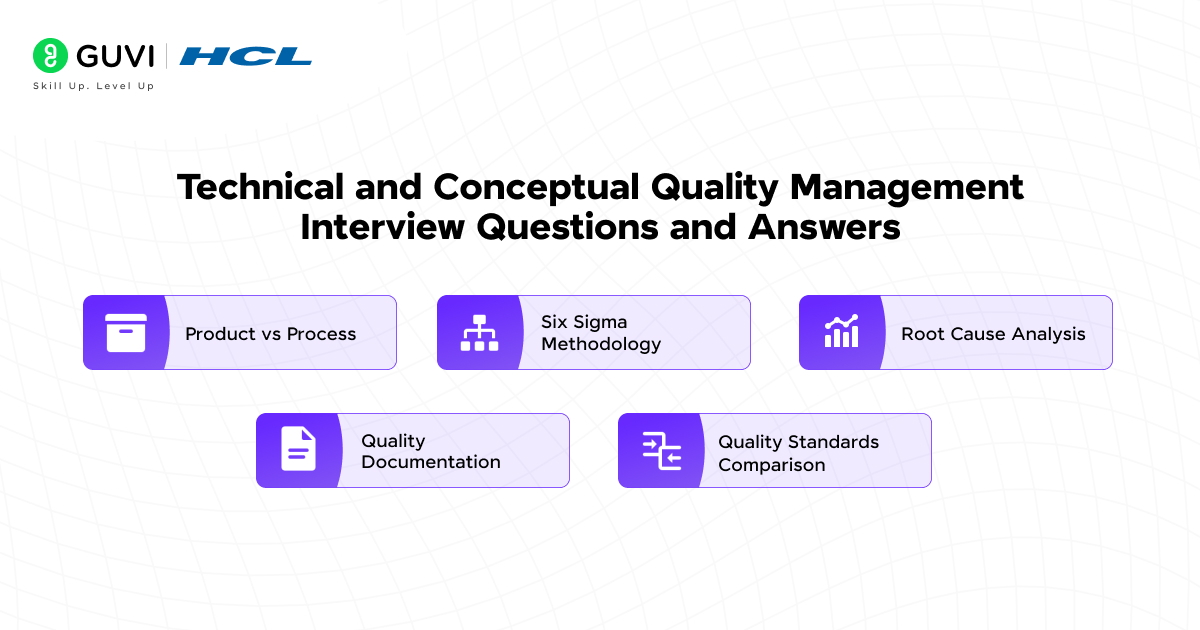
21. What is the difference between product and process quality?
Product quality focuses on the final output’s characteristics and how well it meets customer requirements. It evaluates elements like functionality, reliability, and performance of the end product.
Process quality, meanwhile, examines how efficiently and effectively the production system operates. It concentrates on the methods, systems, and procedures used to create products or deliver services.
Process quality directly impacts product quality—poor processes typically produce inconsistent products. However, good process quality doesn’t automatically guarantee good product quality without proper design specifications. Organizations need both to achieve sustainable quality outcomes.
22. What is Six Sigma, and how is it applied?
Six Sigma is a data-driven methodology aimed at reducing defects and variations in processes. At its core, Six Sigma means achieving no more than 3.4 defects per million opportunities.
Six Sigma uses two key methodologies:
- DMAIC (Define, Measure, Analyze, Improve, Control): Used to improve existing processes
- DMADV (Define, Measure, Analyze, Design, Verify): Used to create new processes or products
In practical application, Six Sigma employs statistical analysis to measure performance and make data-driven decisions. It’s commonly integrated with other quality approaches to reduce waste while increasing customer satisfaction.
23. What is a Fishbone Diagram used for?
A Fishbone Diagram (also called an Ishikawa or cause-and-effect diagram) helps identify possible causes of quality problems by categorizing ideas logically. As one of the seven basic quality tools, it structures brainstorming sessions to find root causes.
The diagram resembles a fish skeleton with the “head” representing the problem and “bones” showing major cause categories—typically the 6Ms: Materials, Machinery, Methods, Measurement, Manpower, and Mother Nature (environment).
24. What is the role of documentation in quality management?
Documentation serves as the backbone of quality management systems, providing:
- Clear communication of processes and standards
- Consistent application of procedures
- Evidence of compliance with standards
- Training resources for employees
- Framework for continuous improvement
Well-structured documentation typically follows a hierarchy from high-level quality manuals to detailed work instructions and records. Despite adding administrative work, effective documentation reduces errors, improves decision-making, and creates valuable organizational knowledge.
25. What is the difference between ISO and CMM?
ISO 9001 and CMM (Capability Maturity Model) differ in several key aspects:
ISO 9001 is a generic quality management standard applicable across industries, focusing on meeting customer and regulatory requirements through a quality management system. It uses certification through third-party audits.
CMM, primarily used in software development, provides a maturity model with five levels (Initial to Optimizing) to assess and improve processes. It focuses more on organizational maturity and continuous improvement than certification.
A level 3 CMM organization would easily obtain ISO certification, while an ISO-certified organization might not satisfy all CMM level 2 requirements.
Concluding Thoughts…
By now, I’m sure you’ve concluded that mastering quality management interview questions undoubtedly requires thorough preparation across multiple knowledge domains. Throughout this guide, we’ve covered essential questions ranging from basic definitions to advanced strategic concepts that interviewers commonly ask candidates at all career stages.
As you prepare for your interview, focus specifically on questions relevant to your experience level while still familiarizing yourself with more advanced concepts. This approach ensures you’re well-equipped to demonstrate both current capabilities and growth potential. Additionally, practicing your responses aloud helps refine your ability to communicate complex quality principles in straightforward, accessible terms. Good Luck!




































Did you enjoy this article?